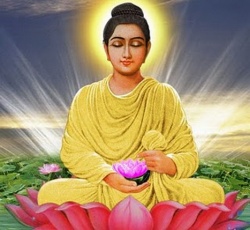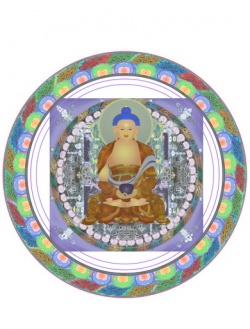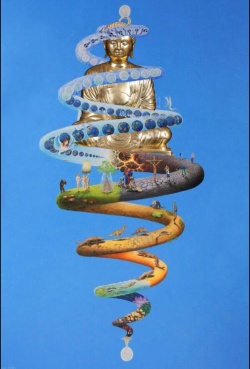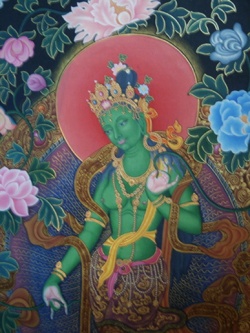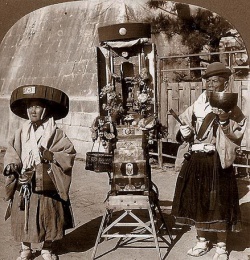The Profound Meaning of Buddhist Ceremonies: Dhamma Offerings
The Profound Meaning of Buddhist Ceremonies: Dhamma Offerings
Following the article in our June 1998 issue, which covered 11 different worship offerings to Lord Buddha, this time we would like to discuss the different worship offerings to Dhamma as follows :-
Dhammas (Preaching Pulpit) : The Dhammas is regarded as a seat that temporarily belongs to a speaker or lecturer who preaches Buddhist Dhamma (Teachings or Doctrine). This seat is similar to the Asna or pulpit that was created as a worship offering to Lord Buddha, but this time it is publicly used with an invited monk as a preacher. Having a similar purpose, a Dhammas is similar to a podium in the west. There are different names for Dhammas, depending on various rural societies or communities especially in Lanna Dhammas Gaew, Asna Gaew, Gradaan Kome, Gradaan Thong, Monthien Kome, Thaen Thesna, Thaen Dhammas, Prasart Gaew, etc.
To Lanna people, low or high ordinary chairs do not command full respect. They had to be built with various images that were related to the story of Buddhism or to traditional architecture. There are 2 kinds of Dhammas that differ in height and splendor:-
Low Dhammas : These were simple and practical and originated from the central plains region of the country. The design was brought to the north in 1932. It is made from wood with artistic designs from the Ayuthaya period. The carvings could be of the Bho Tree, the Lotus, the Naga, the Wheel of the Doctrine, etc. A low Dhammas always has a full seat back and head rest.
High Dhammas : The Lanna people had created their images to represent the monk preacher as a divine being, i.e. Lord Buddha. The seat must be more ornate and beautiful than any ordinary chair. Therefore, in Lanna many years ago, High Dhammas were created that rep- resented palaces or stupas. The front of the Dhammas is always open. The monk preacher has to enter through the front, turn and sit down. Before entering, he must climb 4-5 steps from the floor. This ladder to the Asna is in the form of a Naga. The other three sides of this high square seat are surrounded by balustrades. About 1 meter above the preacher's head, is a high roof pinnacles by a soaring spire, supported by the four up right poles. The beautiful roof is intended to make the Dhammas resemble heaven in miniature. Buddhists worldwide have many things in common, one of which is the wish to worship Dhamma philosophy, and Dhammas can be one of the worship offerings that people can salute and respect.
low Dhamma Most Dhammas are made of teak wood which is intricately carved on the roof, poles, railings, ladders, and high platform. The level of the Asna or seat is about 1 meter above the hall floor for a number of reasons: (1) The preacher's voice can be heard from a greater distance (2) The preacher will gain confidence (3) Better ventilation will increase the preacher's comfort (4) It is easier for the monk preacher to remain aloof from his audience (5) Dhamma, or the Teachings, should be represented from a high level to engender respect.
Kaang Dhamma (Book Shelf) : This shelf is like an open lectern, that does not block the view of the speaker behind, topped by a flat platform. The height is about six inches higher than the level of the Asna on which the preaching monk is sitting. This shelf is placed to the left of the Asna , and the length of the Kaang Dhamma must be equal to the left side of the balustrade.
The main purpose of the Kaang Dhamma is as a rest for the preaching monk's palm leaves recording the Lord Buddha's teachings which can be placed by the monk's assistant before the preacher ascends the Dhammas. There is no formal pattern for the placing of the teachings. The sophistication of decoration is less critical than that of the Dhammas itself and it is not difficult for a carpenter to design, make, and decorate.
Khaan Dham (Round Tray) : round tray A round lacquerware or wooden tray is used to bear the leaves on which are the scriptures. Worshippers lay the long set of palm leaves across the middle of the tray. On each side of the palm leaves, flowers, joss sticks, candles and popped rice would be placed in equal quantities. One side signifies Dhamma for ordinary people or laymen who still struggle with their daily responsibilities. On the other side, a state of mind is represented of those able to recognize the light of truth and end of suffering of the body and mind. This is the meaning of "Dhamma" leading to "Nibbana."
Kumpee Dhamma (Record of Buddhism Doctrine) : There were such Buddhist scriptures or written records for five centuries after Lord Buddha's attainment of Nibbana. It was the great heritage of senior monks who memorized and transferred Dhamma from one to another during those early years. Later , with the gradual development of science and technology, written records came into being. The words "Kumpee Dhamma " actually mean " The Profound Scriptures of Buddhist Philosophy". However, nowadays people take it for granted that the word Kumpee means something like a Treatise or a Bible. For centuries, the materials used for written scripture records have been palm leaves, Sa paper, and Khoy paper.
The way that palm leaves were used for recording Buddhist texts is quite amazing. Each dry palm leaf is between 2.2 and 2.5 inches wide, but of differing lengths, and is white or pale yellow in color. The proper way to inscribe or engrave on these leaves was with a metal nib or stylus. Both sides of each leaf were written on. A mixture of carbon black and resin or tree sap could be applied afterwards for better absorption and preservation of the text. Later, a piece of fresh coconut meat is used to polish both sides of the palm leaves so that they are clean and the writing is clear. One quire, called a "Bhoog", consists of about 24 leaves bound together with two strings or threads running through holes on both edges of the pages. This thread is called "Sai sayong". Sometimes, for convenience, only one string was used on the binding edge. Both the front and back covers are always beautifully decorated with Thai drawings. Each is encased in its own beautiful sheath or bag for protection, and to ensure the "Bhoog" could be stored in an orderly fashion.
For practical purposes, women' hair can be used along with thread. The mixture of hair, with its smoothness, and thread make it easier for the monks who flip over the palm leaves . Also, the hair and thread maintain the shape and size of the holes. Local beliefs say that the women may more easily reach heaven or become more intelligent if they offer their hair to the ceremony of Kumpee Dhamma making.
Historically, China and the northern kingdoms of the Indian subcontinent developed early techniques of paper production. Lanna (northern Siam) probably absorbed their science and used it to make the covering part for umbrellas from the "Paper Mulberry" (or, in Thai, "Sa") tree. This type of paper has been made here for centuries. The botanical name of the tree is Broussonetia papyrifera. Instead of using a soft wood, the inner bark of this tree is softened by a digestion technique an example of primitive science.
By contrast, "Khoy" paper has been used for centuries in the central and southern regions of Thailand. The botanical name for the small tree from which this comes is Streblusasper moraceae. Similar trees such as Phyllochlamys spinosa and Balanostrebus iticifolia have also sometimes been used. The digestion technique used for the bark of these trees is similar to "Sa production". Sa paper may be suitable for umbrella making, but it is not good enough for writing (although attempts are presently being made to refine it for use as art paper) because it ages too quickly. Khoy paper, by contrast, can be kept for a hundred years. Although modern chemistry has greatly evolved, our ancestors at least knew how to blend wood pulp with tree resins or sap. The color of Khoy paper can be black or white, depending on which pigments are applied as binding and anti-aging agents. The paper's texture is quite coarse, somewhat similar to the paper used for photo albums in the old days. Books made with this kind of paper were "accordion-folded" and written on continuously down the length of one side until it was filled, then the paper would be turned over and the text continued on the back. The average size of a "Khoy" book is about 6.5 X 14.5 inches.
There are two different types of Khoy paper books, varying according to the writing medium:
Sa-mood Thai Dum (Black Record Book)
Written with white talc.
Written with yellow ink (horadarn)
Sa-mood Thai Dum or Sa-mood Thai Khao (Black or White Record Book)
Written with ink of mixed color: "Sa-mood Sehn Rongk"
Written with glue onto which gold-leaf was pressed: "Samood Sehn Thong"
Thai culture has produced many kinds of beautiful royal record books. Most old Wat or temples have Khoy books while present-day examples of palm leaves can be purchased as souvenirs in any of the many Buddhist supply shops around Chiangmai. A number of these shops, which also sell monk's robes, alms bowls, etc., can be found in the Warorot market area of the city.
Buddhist people in Lanna have regarded Kumpee Dhamma as supreme objects next only to the Buddha image itself. For this reason they have handcrafted the covers or bags made of cloth or woven bamboo so that the Kumpee Dhamma will be protected from wetting or aging. Such is their respect for Kumpee Dhamma people believe that if a woman knits a cloth bag for Kumpee Dhamma, her daughter or son will be raised up easily and will be more clever or disciplined than other children.
Heed Dhamma or Heeb Dhamma (Scripture Trunk): The word "Heeb" means box, case, trunk or chest. Because the Dhamma Scripture is the one of most respected objects, it is more appropriate to use a word for a trunk of scriptures that is different from the ordinary word for box, thus the word "Heeb" became "Heed". This is a complete set of scriptures, not a small portable set which can be easily carried by a monk. Buddhists would want to permanently store the scriptures in a large trunk that can protect the scriptures from moisture and insects. There are two fundamentally different trunk designs:-
The trunk is an elongated cubic shape with an height appropriate to its contents. The four sides and the lid are beautifully carved or painted. The trunk itself is placed on a strong base. There are four cylindrical steel legs attached to the four corners under the base. When people want to move this heavy trunk, strong rope will be used and tied to the four legs. Inside, there is an inner trunk a little smaller than the main trunk. The en tire storage is in effect a double trunk with inner and outer shells.
This is not so much a trunk, but rather more like a cupboard, wardrobe or clothes chest. There are two doors, left and right. Under this Heed Dham is a large rectangular base. The whole set is not as tall as an ordinary wardrobe, and about half the length of a coffin on a high base.
Both Heed Dham and its base are beautifully carved or painted. The design on the surface is covered with gold or silver foil, in a style called "Rod Naam" in Thai, meaning "washed with water". At the final stage of crafting this kind of decoration, the object is washed to remove any unwanted gold foil, leaving the beautiful gilded design standing out.
Mhai - Gub Dham (Wooden Press) : As mentioned earlier, the Buddhist scriptures or "Dhamma" have been recorded on palm leaves for centuries. Even though palm leaves are treated before and after inscription, they are still not entirely flat. In order to remove any remaining wrinkles, the palm leaves must be placed between two thick, heavy wooden blocks, which press the palm leaves perfectly. Palm leaves are used not only for Dhamma but also for the ordination of monks.
Each pair of Mhai - Gub Dham is made of wood several inches thick. Each piece is cut into a long rectangle. These are lovingly coated with lacquer and beautifully gilded using the technique of "Rod Naam" mentioned above.
Bunshug Dhamma (Teachings' Labels) Buddhists in ancient times knew how to list, classify, systemize, categorize, and label Buddhism doctrine properly. Each set of Kumpee Dhamma may be a single text or a combination of related groups of doctrine. It is essential to have a proper label on the top of the Kumpee Dhamma. A small piece of wood is cut with dimensions of about 1 X 6 inches, sufficient for one or two lines of information to be written as a label for the Kumpee Dhamma. Both ends of this Bunshug Dhamma are intricately carved.
Various Types of Dhamma
Dhamma Wattr is the name of the Kumpee Dhamma which is taught to people who are of the right age, right character, right thinking, etc.
Dhamma Krao is the name of a group of Buddhist Doctrines that covers the stories of previous lives of Lord Buddha. The word Krao means "chain" which is a connection to the real doctrine. Listeners would enjoy these stories, while various doctrines were woven into the tales.
Dhamma Tone is a compact Kumpee Dhamma which is written and engraved within one Bhoog of palm leaves.
Dhamma Phee Dtye is a Kumpee Dhamma used as an obituary.
Dhamma Shata is a Kumpee Dhamma which was arranged and assembled on the occasion of the giving of a proper horoscope according to a person's day,month and year of birth.
Dhamma Anisong is the Kumpee Dhamma that covers the stories of those who devote their time, life and money to helping others. Such people deserve to receive good Karma.
Dhamma Mahachart is the Kumpee Dhamma that covers the last life of Lord Buddha before he was born as Prince Siddhartha. This was as the popular and emotive Prince Vessandorn. It teaches people the errors of selfishness and the virtues of self-sacrifice.
